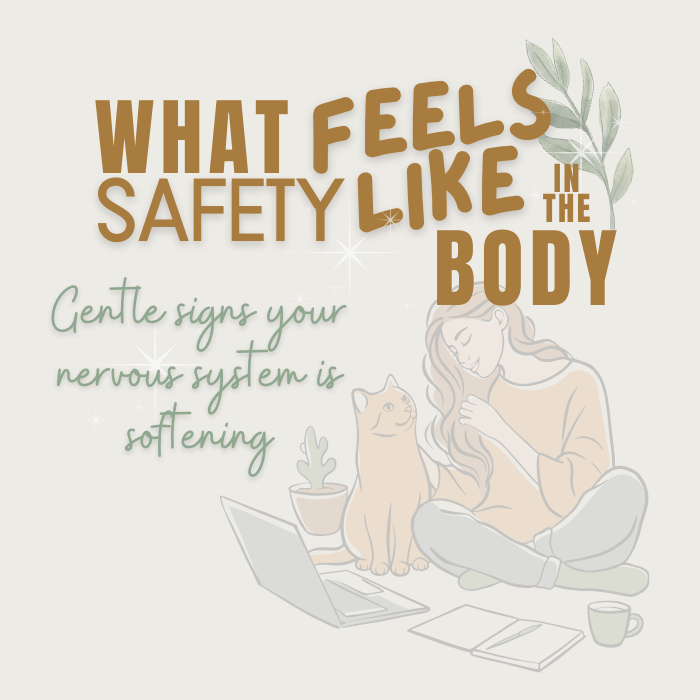A gentle guide to recognizing and nurturing your inner safety
We often talk about “feeling safe” — but for many of us, true safety in the body is unfamiliar.
When you’ve spent years in survival mode, hypervigilance can feel normal.
Tension might feel like focus. Numbness might feel like calm.
So when the body begins to soften, it can feel strange. Even unsettling.
That’s okay.
Re-learning safety is about the felt experience.
Some links on this page are affiliate links. If you choose to purchase through them, it supports this site at no extra cost to you. Thank you for your support. 🤍
Why We Lose Touch with Safety
The body is designed to protect us, to help us survive.
When something feels dangerous, our nervous system shifts into fight, flight, freeze, or fawn — and that shift is not always conscious.
If danger is frequent (or subtle but chronic), the body forgets what calm feels like.
It adapts to always being ready.
Over time, this becomes the baseline.
So when something safe finally happens —
a quiet moment, a kind word, stillness —
the body might not know what to do with it. And might not trust it. It might even reject it.
What Safety Actually Feels Like in the Body
Here are some gentle signs your nervous system is beginning to feel safe:
- Shoulders naturally drop
- Jaw softens
- Breathing slows (especially the exhale)
- Eyes stop scanning the room
- You feel connected to your body (not floating above it)
- A quiet sigh, yawn, or belly gurgle arises spontaneously
- You can hold eye contact (without needing to)
- You feel okay being still, without needing to “do”
- You notice emotion without being overwhelmed by it
Not all will be present at once — and that’s okay.
While these soft signals of safety can arise in solitude, they also often emerge in the presence of another — a steady voice, a calm gaze, a moment of warmth. Our nervous systems are relational by nature. If you’d like to explore this more deeply, you may resonate with this reflection on why co-regulation matters.
It Might Not Feel Comfortable at First
When people pleasing becomes a survival strategy, — it embeds itself in the body. Chronic tension, shallow breathing, or a tight chest can be signs of long-held appeasement. This guide on how people pleasing affects your body explores this somatic layer.
Safety is not always immediately relaxing.
Sometimes, when tension releases, old grief or fear surfaces.
That’s part of the tension letting go and unwinding.
✨ Softness can feel vulnerable.
✨ Stillness can feel scary.
✨ Calm can feel boring or even unsafe, triggering panic — at first.
It means you’re entering new territory.
The key is to go slowly enough that your body can begin to trust.
A Gentle Practice to Begin
Try this when you have a quiet moment:
- Sit or lie down somewhere comfortable.
- Place a hand on your chest or belly.
- Say silently or aloud: “I am safe right now.”
“It’s okay to soften.” - Notice any sensations — tension, openness, nothing at all.
You don’t need to change them. Just notice. - Stay for 2–3 minutes, breathing softly.
- End by thanking your body, even if it didn’t feel different: “Thank you for being with me.”
This practice isn’t about instant calm — it’s about building a bridge back to trust.
What This Makes Possible
When your body learns to feel safe:
- You react less from fear or lack
- You can express yourself with more ease
- You connect more deeply with others
- You sleep better
- You stop bracing for the next “hit” from life
🌿 FAQ
How do I know if what I’m feeling is safety or shutdown?
Safety feels soft and connected. Shutdown often feels heavy, numb, or far away. With practice, you’ll learn to sense the difference. If you’re unsure, move gently and check in with your breath and presence.
If you’re in a space where you feel deeply disconnected or like nothing matters, you may be in a state of collapse or nervous system shutdown. This guide offers support for those moments and explains why they’re signs of your body’s protective wisdom.
What if I feel unsafe even when nothing is wrong?
That’s incredibly common — especially if safety wasn’t modeled in childhood. Your nervous system might still be wired for past threat. Each small moment of presence and compassion helps to rewire this over time.
Next Steps to Explore
You might also resonate with:
- Grounding Practices to Calm the Nervous System
- Compassion as a Healing Tool
- Listening to the Body’s Quiet Signals
These tools can support your journey into feeling not just okay — but deeply held in your own body.
Gentle Support Resources
To deepen the understanding of why safety can feel strange at first, this article provides a helpful foundation from a polyvagal lens:
→ Polyvagal Theory: A Beginner’s Guide
The Mindful Self-Compassion Workbook
A warm, research-backed invitation to build internal safety through kindness.
Written by Kristin Neff and Christopher Germer, this workbook pairs well with the themes of re-learning safety and presence in the body.
Vagus Nerve Deck: 75 Exercises to Reset Your Nervous System
Simple, accessible practices to build vagal tone and gently return the body to calm.
Ideal for when safety feels unfamiliar — this deck helps your body relearn what regulation can feel like.
Your unfolding is already underway — and it’s beautiful.


Much needed exercises!!!